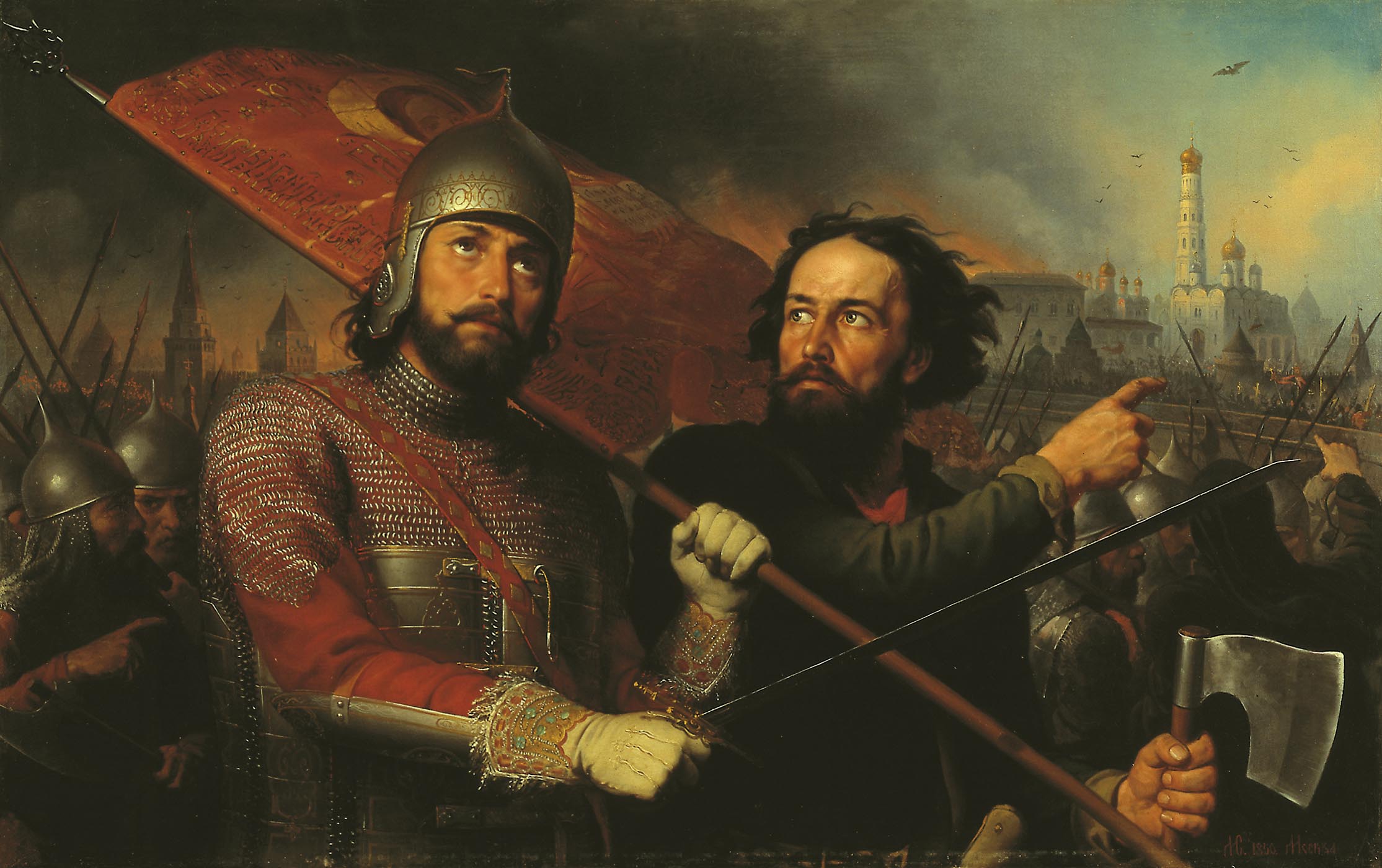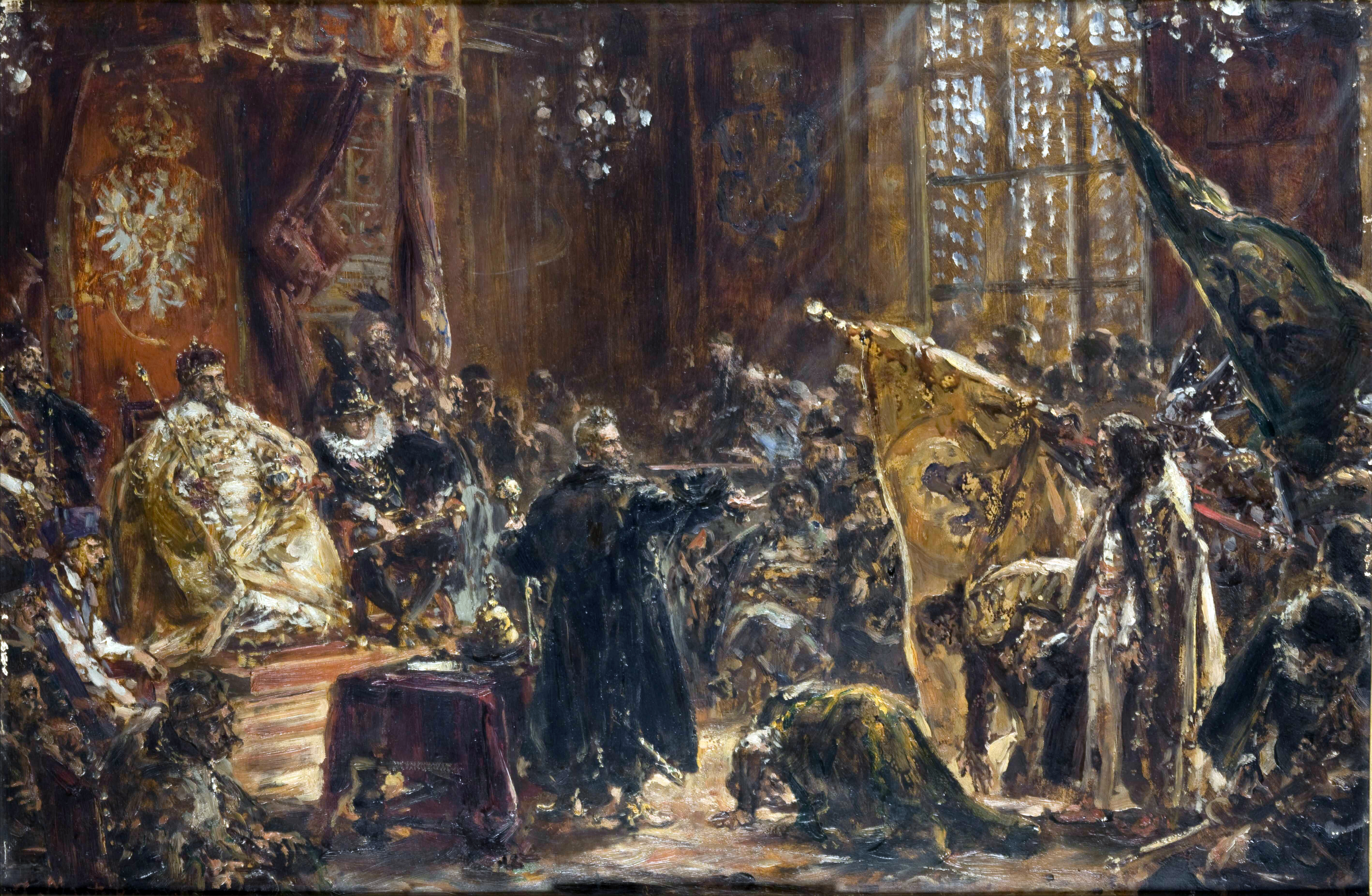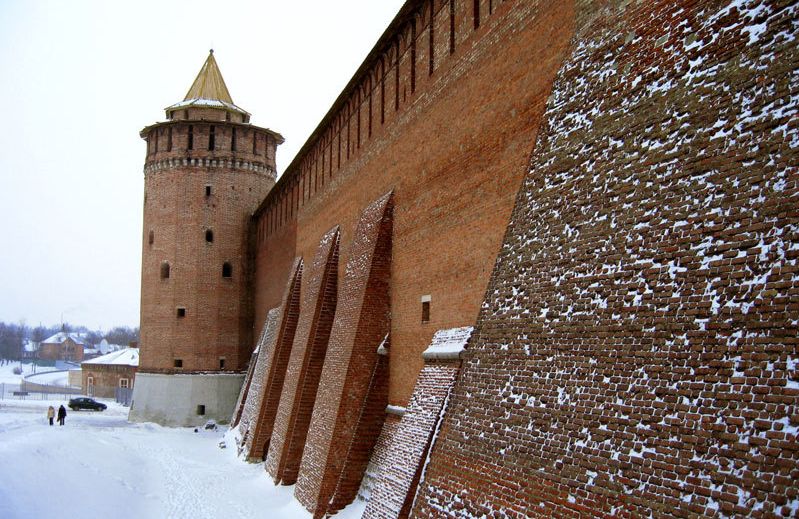|
Dmitry Pozharsky
Dmitry Mikhaylovich Pozharsky ( rus, –Ē–ľ–łŐĀ—ā—Ä–ł–Ļ –ú–ł—Ö–įŐĀ–Ļ–Ľ–ĺ–≤–ł—á –ü–ĺ–∂–įŐĀ—Ä—Ā–ļ–ł–Ļ, p=ňądm ≤itr ≤…™j m ≤…™ňąxajl…ôv ≤…™t…ē p…źňą źarsk ≤…™j; 17 October 1577 ‚Äď 30 April 1642) was a Russian prince known for his military leadership during the Polish‚ÄďMuscovite War from 1611 to 1612. Pozharsky formed the Second Volunteer Army with Kuzma Minin in Nizhny Novgorod against the Polish‚ÄďLithuanian Commonwealth's occupation of Russia during the Time of Troubles, resulting in Polish withdrawal after Russian victory at the Battle of Moscow in 1612. Pozharsky received the unprecedented title of ''Saviour of the Fatherland'' from Mikhail I of Russia, becoming a folk hero in Russian culture and honored in the Monument to Minin and Pozharsky in Moscow's Red Square. Early career Dmitry Mikhaylovich Pozharsky is considered to have been born on 1 November 1578 in Klin County, in the north of Moscow Governorate of the Tsardom of Russia. Pozharsky was descended from a dynasty of m ... [...More Info...] [...Related Items...] OR: [Wikipedia] [Google] [Baidu] |
Kuzma Minin
Kuzma (Kozma) Minin (; full name Kuzma Minich Zakhariev-Sukhoruky, born late 1570s - died 1616) was a Russian merchant from Nizhny Novgorod, Russia, who, together with Prince Dmitry Pozharsky, became a national hero for his role in defending the country against the Polish invasion in the early 17th century.'' ..igismund, changing his mind, demanded direct personal control of Russia and continued the Polish invasion (autumn 1610). This finally stimulated the Russians to rally and unite against the invader."''from:Troubles, Time of" Encyclop√¶dia Britannica. 2006. Encyclop√¶dia Britannica Premium Service. 12 June 2006 (accentuation added)''During the "Time of Troubles" (1598‚Äď1613), ozharskyfought against the Poles, who, taking advantage of unstable political conditions, had invaded Russia. In 1611 he took command of a national militia formed on the initiative of the merchant Kuzma Minin of Nizhny Novgorod. With his improvised army he marched on Moscow (1612) and drove out the Po ... [...More Info...] [...Related Items...] OR: [Wikipedia] [Google] [Baidu] |
Beklemishev
Beklemishev, a Russian surname of Turkic origin (means "guard"). * Vladimir Beklemishev (other), a name of several Russian people * Yury Krymov, a pen name of Yuriy Beklemishev *Lev Beklemishev, a mathematician affiliated with the Steklov Mathematical Institute of the Russian Academy of Sciences in Moscow {{Surname Russian-language surnames ... [...More Info...] [...Related Items...] OR: [Wikipedia] [Google] [Baidu] |
False Dmitry II
False Dmitry II ( rus, –õ–∂–Ķ–ī–ľ–ł—ā—Ä–ł–Ļ II, Lzhedmitrii II; died ), historically known as Pseudo-Demetrius II and also called "—ā—É—ą–ł–Ĺ—Ā–ļ–ł–Ļ –≤–ĺ—Ä" ("rebel/criminal of Tushino"), was the second of three pretenders to the Russian throne who claimed to be Tsarevich Dmitry Ivanovich, the youngest son of Ivan the Terrible, during the Time of Troubles. The real Dmitry had died under uncertain circumstances, most likely an assassination in 1591 at the age of nine at his widowed mother's appanage residence in Uglich. The second False Dmitry first appeared on the scene around 20 July 1607, at Starodub. He is believed to have been either a priest's son or a converted Jew, and was relatively highly educated for the time. He spoke both the Russian and Polish languages and was something of an expert in liturgical matters. He pretended at first to be the Muscovite boyar Nagoy, but falsely confessed under torture that he was Tsarevich Dmitry, whereupon he was taken at his word and jo ... [...More Info...] [...Related Items...] OR: [Wikipedia] [Google] [Baidu] |
Zaraysk
Zaraysk (russian: –ó–į—Ä–įŐĀ–Ļ—Ā–ļ) is a town and the administrative center of Zaraysky District in Moscow Oblast, Russia, located about southeast from Moscow. Population: Geography The town stands on the right bank of the Osyotr River, which is a right confluent of the Oka. History In the Middle Ages, the town belonged to the Princes of Ryazan and was known as Krasnoye (13th century) and Novogorodok-upon-the-Osyotr (14th and 15th centuries). From 1528 onwards, the town was called "the town of Nikola Zarazsky" and only by the beginning of 17th century it received its present name of Zaraysk. Before the 20th century, the town was a part of Ryazan Governorate and its architecture and vernacular dialect seem closer to Ryazan than to Moscow. In the Grand Duchy of Moscow, Zaraysk was one of the fortresses forming a part of the Great Abatis Border, a fortified line of felled trees, barricades, fortresses, ditches, which were built by Russians as a protection against the hordes of th ... [...More Info...] [...Related Items...] OR: [Wikipedia] [Google] [Baidu] |
Pekhorka River
The Pekhorka (russian: –ü–Ķ—Ö–ĺŐĀ—Ä–ļ–į) is a river in the Moscow Region in Russia, a left tributary of the Moskva. It is long, and has a drainage basin of .¬ę–†–Ķ–ļ–į –ü–ē–•–ě–†–ö–ź¬Ľ Russian State Water Registry Flows from the north point in 1,5 km from Lukino village to the south, where it passes through Izmailovo, and Kosino (that part of the river in Moscow ... [...More Info...] [...Related Items...] OR: [Wikipedia] [Google] [Baidu] |
Ivan Bolotnikov
Ivan Isayevich Bolotnikov (russian: –ė–≤–įŐĀ–Ĺ –ė—Ā–įŐĀ–Ķ–≤–ł—á –Ď–ĺ–Ľ–ĺŐĀ—ā–Ĺ–ł–ļ–ĺ–≤; 1565‚Äď1608) headed a popular uprising in Russia in 1606‚Äď1607 known as the Bolotnikov Rebellion (–í–ĺ—Ā—Ā—ā–į–Ĺ–ł–Ķ –ė–≤–į–Ĺ–į –Ď–ĺ–Ľ–ĺ—ā–Ĺ–ł–ļ–ĺ–≤–į). The uprising formed part of the Time of Troubles in Russia. Early life Describing Bolotnikov, Paul Avrich states, "Contemporaries depict him as tall and powerfully built and as an intelligent and energetic leader." Bolotnikov was a slave of Prince Andrei Teliatevsky, before running away to join the Cossacks along the steppe frontier between Muscovy and the Crimean Khanate. Captured by the Crimean Tatars, he was sold into slavery as a helmsman for a Turkish galley. Liberated in a sea battle by German ships, he was taken to Venice. Journeying back to Muscovy, he passed through Poland, where he heard tales of the Tsar Dmitri. This led Bolotnikov to Sambor, where he met Mikhail Molchanov. Molochanov was part of the group who had murdered Feodor ... [...More Info...] [...Related Items...] OR: [Wikipedia] [Google] [Baidu] |
Cossacks
The Cossacks , es, cosaco , et, Kasakad, cazacii , fi, Kasakat, cazacii , french: cosaques , hu, koz√°kok, cazacii , it, cosacchi , orv, –ļ–ĺ–∑–įŐĀ–ļ–ł, pl, Kozacy , pt, cossacos , ro, cazaci , russian: –ļ–į–∑–į–ļ–łŐĀ or , sk, koz√°ci , uk, –ļ–ĺ–∑–į–ļ–łŐĀ are a predominantly East Slavic Orthodox Christian people originating in the Pontic‚ÄďCaspian steppe of Ukraine and southern Russia. Historically, they were a semi-nomadic and semi-militarized people, who, while under the nominal suzerainty of various Eastern European states at the time, were allowed a great degree of self-governance in exchange for military service. Although numerous linguistic and religious groups came together to form the Cossacks, most of them coalesced and became East Slavic-speaking Orthodox Christians. The Cossacks were particularly noted for holding democratic traditions. The rulers of the Polish-Lithuanian Commonwealth and Russian Empire endowed Cossacks with certain sp ... [...More Info...] [...Related Items...] OR: [Wikipedia] [Google] [Baidu] |
Vasily IV
Vasili IV Shuisky (russian: –í–į—Ā–ł–Ľ–ł–Ļ IV –ė–≤–į–Ĺ–ĺ–≤–ł—á –®—É–Ļ—Ā–ļ–ł–Ļ, ''Vasiliy IV Ivanovich Shuyskiy'', c. 155212 September 1612) was Tsar of Russia between 1606 and 1610 after the murder of False Dmitri I. His rule coincided with the Time of Troubles. He was the only member of House of Shuisky to become Tsar and the last member of the Rurikid dynasty to rule as tsar. Life He was a son of Ivan Andreyevich Shuisky. Born Prince Vasili Ivanovich Shuisky, he descended from sovereign princes of Nizhny Novgorod and was a 20th-generation male-line descendant of the 9th-century Varangian prince Rurik. Vasili Ivanovich was one of the leading boyars of the Tsardom of Russia during the reigns of Feodor I () and Boris Godunov (). In the court intrigues of the Time of Troubles (1598‚Äď1613), Vasily and his younger brother Dmitry Shuisky usually acted together and fought as one. It was Shuisky who, in obedience to the secret orders of Tsar-to-be Boris, went to Uglic ... [...More Info...] [...Related Items...] OR: [Wikipedia] [Google] [Baidu] |
Kolomna
Kolomna ( rus, –ö–ĺ–Ľ√≥–ľ–Ĺ–į, p=k…źňąlomn…ô) is a historical types of inhabited localities in Russia, city in Moscow Oblast, Russia, situated at the confluence of the Moskva River, Moskva and Oka Rivers, (by rail) southeast of Moscow. Population: History Mentioned for the first time in 1177, Kolomna was founded in 1140‚Äď1160 according to the latest archaeological surveys. Kolomna's name may originate from the Old East Slavic, Old Russian term for "on the bend (in the river)", especially as the old city is located on a sharp bend in the Moskva River, Moscow River. In 1301, Kolomna became the first town to be incorporated into the Moscow Principality. Like some other ancient Russian cities, it has a Kolomna Kremlin, kremlin, which is a citadel similar to the Moscow Kremlin, more famous one in Moscow and also built of red brick. The stone Kolomna Kremlin was built from 1525‚Äď1531 under the Russian Tsar Vasily III. The Kolomna citadel was a part of the Zasechnaya cherta, Great ... [...More Info...] [...Related Items...] OR: [Wikipedia] [Google] [Baidu] |
Stolnik
Pantler (, , russian: —Ā—ā–ĺŐĀ–Ľ—Ć–Ĺ–ł–ļ, ) was a court office in Lithuania, Poland, and Russia, responsible for serving the royal table, then an honorary court title and a district office. Stolnik in Crown of Poland In the Crown of Poland under the first Piast dukes and kings, this was a court office. From the 14th century, it was an honorary court title in the Kingdom of Poland, since the 16th century. * Grand Pantler of the Crown () * Pantler of the Crown () * Court Pantler of the Crown () According to the 1768 district office hierarchy, the Pantler's position in the Crown of Poland was superior to that of Deputy cup-bearer and inferior to that of district judge. Stalininkas in Lithuania In Lithuania, the pantler's position emerged in the late 15th century, comparatively later than MarŇ°alka, Treasurer, and Cup-bearer, with the first Grand Pantler of Lithuania, , being known from 1475. Initially, the pantler's took care of the Grand Duke's food warehouses, distributi ... [...More Info...] [...Related Items...] OR: [Wikipedia] [Google] [Baidu] |
Russian Nobility
The Russian nobility (russian: –ī–≤–ĺ—Ä—Ź–Ĺ—Ā—ā–≤–ĺ ''dvoryanstvo'') originated in the 14th century. In 1914 it consisted of approximately 1,900,000 members (about 1.1% of the population) in the Russian Empire. Up until the February Revolution of 1917, the noble estates staffed most of the Russian government and possessed a Gentry assembly. The Russian word for nobility, ''dvoryanstvo'' (), derives from Slavonic ''dvor'' (–ī–≤–ĺ—Ä), meaning the court of a prince or duke (''kniaz''), and later, of the tsar or emperor. Here, ''dvor'' originally referred to servants at the estate of an aristocrat. In the late 16th and early 17th centuries, the system of hierarchy was a system of seniority known as ''mestnichestvo''. The word ''dvoryane'' described the highest rank of gentry, who performed duties at the royal court, lived in it (''Moskovskie zhiltsy''), or were candidates to it, as for many boyar scions (''dvorovye deti boyarskie'', ''vybornye deti boyarskie''). A nobleman is call ... [...More Info...] [...Related Items...] OR: [Wikipedia] [Google] [Baidu] |




